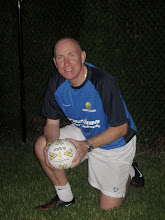During my 15 year coaching career the question that I am most commonly asked is "how are talented young soccer players developed?" "What is the secret?".
The pursuit of this answer drives many of us on and the quest has taken me to Crewe Alexandra Football club in England, discussions with top youth and professional coaches throughout the world and several hours of coaching education in the United Kingdom, Canada and the United States.
- Futebol de Salão
- Emphasis on Individual Skills
- Increased time training
- Physical Training
Daniel Coyle, author of the Talent Code, reviewed Simon's methods and concluded that young Brazilian players are the most skilful because ".....they’ve been practicing that creativity for their entire lives." On his blog, Daniel illustrates how the game of futbol de salao has helped create one of the world’s greatest players: during the last 10 years - Ronaldinho of Brazil. The early part of the video illustrates Ronaldino's close control, vision and anticipation of the play.
The video then takes us back to where it all began for young Brazilian players like Ronaldino - the futbol de salao court. Their skills were developed in this environment and their creativity was nurtured and developed. They were limited only by the extent of their own imaginations. A far cry from the normal development path of young Canadian players.....who are often handed an extra-small size shirt at aged 2, in U3 house-leagues, and instructed to go and play! When they get older we then pack the sidelines....and instruct them to "take a big kick!"
In truth we are not helping our younger players. We are not providing them with an environment that they can succeed in at aged 2. They should we working 1:1 with their parents at that age and spending time getting used to different parts of the foot. From there, they should be spending a significant amount of time each week with the ball on an individual basis - 20 hours a week if they wish to match the experience of young Brazilian players. Success and measurements should be based on their number of consecutive juggles, the number of pele sprints they can perform in 30 seconds ...not how many trophies they have won!
We now have 100 players/week in our program....as Daniel Coyle stated in his best selling book "The Talent Code".....in reference to the work of Simon Clifford and Brazilian Soccer Schools.....more stars are on their way!
To learn more about our Brazilian Soccer Schools work in Canada, visit our website at www.icfds.com/burlington or visit the Brazilian Soccer Schools UTube Channel at www.youtube.com/user/BSSchannel
Daniel Coyle is the author of The Talent Code Journalist and New York Times bestselling author Daniel Coyle visited nine of the world’s greatest talent hotbeds — tiny places that produce huge amounts of talent, from a small music camp in upstate New York to an elementary school in California to the baseball fields of the Caribbean.
He found that there’s a pattern common to all of them — certain methods of training, motivation, and coaching. This pattern, which has to do with the fundamental mechanisms through which the brain acquires skill, gives us a new way to think about talent — as well as new tools with which we can unlock our own talents and those of our kids.
You can follow Daniel's work at http://thetalentcode.com/





By constitutional determination regarding the educational system, the aforementioned legislation still applies as long as it does not go against the Constitution. This ambiguity is a consequence of the absence of a new Bases and Guidelines Law and characterizes a transition phase until the new law is finally elaborated and enacted. The bill has already been submitted to congress.
ReplyDeletejimmy
info@ibowtech.com
http://www.sangambayard-c-m.com